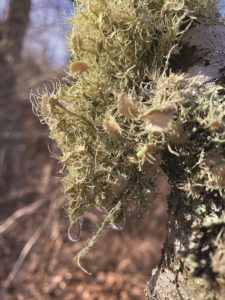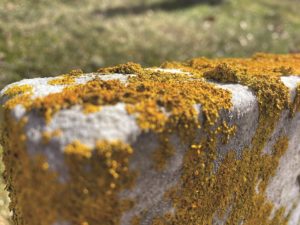There’s a bend in the road on the way to the dump in Wellfleet. The road winds through a low, wet area, a tributary of the Herring River. As far as you can see, there are black cherry trees, standing in a swamp of skeletal, bare branches that point to the sky. They are mostly dead. But when the air is wet, after a rain or when a heavy mist settles in, the entire swamp seems to swell and glow with life again. A reminder that where there is death, there is, invariably, life. There’s another lesson there, too. A quiet, ancient little love story.

The branches of these trees are covered in lichen. Lichens are the result of two organisms deciding to work together — fungi and algae living in a mutualistic relationship. The fungal partner supplies structure, nutrients, and water. The algae live on the filament structures of the fungi and provide food from photosynthesis.
Think of the algae as the leaves of a tree, and the fungi as the roots and stems. They are classified as fungi because the fungal component is the more prominent partner in this coupling. But it takes both of them to be lichen. Together, they share resources, give one another support, provide a solid foundation on which to build a life. They stick together. And it works.
There are around 20,000 known species of lichen. About 400 can be found on Cape Cod. Lichens cover 6 to 8 percent of the Earth’s land surface. They are found everywhere from the Arctic tundra to the deserts and can grow on almost any surface.
Once you start to take notice of these remarkable organisms, you find them on everything. They decorate gravestones with intricate patterns and vibrant colors. Aqua greens and mustard yellows. They grow in the hot, dry, seemingly sterile sand of the dunes. Find me a tree over 10 feet tall that doesn’t have tufts of wiry green in its upper branches. Their folded forms can be found on metal, the fiberglass of a boat hull, the rubber gasket of your car’s windshield. It seems to be quite a successful union these fungi and algae have formed.
Lichens have beautifully chosen names. The species growing on the dead trees in the swamp is called old man’s beard. It’s an unkempt snarl of gray-green threads and knots. There’s one that grows as a slick, warty film in soggy areas that’s called toadskin lichen. Another looks like the ruffled folds of kale leaves with a powdery, glaucous finish. Its name is powdered ruffle lichen. Barnacle lichen. Bloodstain lichen. Crab’s eye lichen. Egg yolk lichen. Chocolate chip lichen. Sunburst lichen. I’m not making these up. It seems the rule for identifying and naming a lichen is to think of the first thing it reminds you of, and without an ounce of hesitation, say it out loud. Blistered navel lichen. Look it up.

I try to go to the dump on days after it has rained, or when there is warmth and humidity in the air, so that I can see the lichen. They glow the color of oxidized copper. The swamp seems to be breathing: the lichens swollen to twice their dry size, lush as they drink the moisture from the air. The swamp trees almost look like they are alive again. In some way they are.
And the love story. The lichen. Two very different forms of life, bringing their respective strengths and supporting each other’s deficits to go further and do more. To thrive. Lessons sometimes hit you hard. Other times they surround you with a million intricate multicolored examples, waiting for you to finally notice them.



